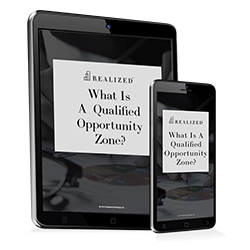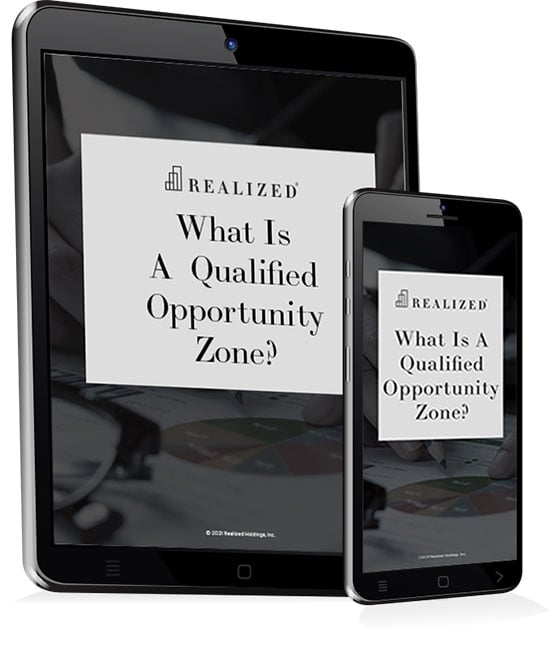
In December 2017, the Tax Cuts and Jobs Act was passed, offering a brand-new tax incentive for investors called Qualified Opportunity Zones (QOZs). Through the Qualified Opportunity Zones program, the federal government certified distressed, low-income communities throughout the United States as Qualified Opportunity Zones, providing much-needed resources to communities in need while offering tax advantages to those who invest in these neighborhoods.
Investors have the opportunity to invest in these Opportunity Zone areas through an investment vehicle called a Qualified Opportunity Fund, discussed in further detail below.
What are the Tax Benefits of Investing in an Opportunity Zone?
When an investor sells an investment, they are required to pay tax on the amount that the asset has appreciated – which is called capital gains tax. This tax can be quite costly and can significantly eat into an investor's profit. However, when an individual chooses to invest in a Qualified Opportunity Zone, they can defer (or postpone) the hefty capital gains tax.
Several tax incentives apply to investing in a QOZ. If an investor holds funds in the investment for at least five years, there will be a 10% reduction on the original capital gains liability. If the investment is held for at least seven years, there will be an additional 5% reduction in that original capital gains liability. However, the QOZ investment must be held for at least seven years by 2026 to qualify for the additional 5% reduction, meaning the investment must be made by the end of 2019 to qualify for this tax incentive.
The final, and potentially most significant, tax incentive applies when the QOZ investment is held for at least ten years. After ten years, the tax basis of the QOZ investment automatically steps up to its fair market value, therefore eliminating the liability on the investment for any capital gains it has experienced within the QOZ. Click here to view a standard QOZ timeline.
What is a Qualified Opportunity Fund (QOF)?
When an investor sells property with the intent to reinvest those capital gains into a Qualified Opportunity Zone, those funds are deposited into a Qualified Opportunity Fund. 90 Percent of the Qualified Opportunity Fund's holdings must be invested into a property (QOZP), businesses (QOZBP), or partnerships (QOZ Partnership Interests) within a Qualified Opportunity Zone.
A QOF ownership structure can be set up either as a corporation (typically as a REIT) or a partnership (LLC). Each entity structure has different tax and cash flow distribution implications. An investor needs to review each offering carefully and consult with a tax professional for advice.
What is the difference between investing in a Qualified Opportunity Fund and transacting a 1031 exchange?
Investing in a Qualified Opportunity Fund has similar tax incentives to a 1031 exchange because both options allow the investor to defer capital gains tax. However, in addition to the tax incentives discussed earlier in this article, there is a significant difference between these two investment vehicles:
Original Investment
When an investor executes a 1031 exchange, they must purchase a "like-kind" property that qualifies as real estate held for investment or productive use in a trade or business.
A QOF, on the other hand, allows investors to defer the gains tax from the sale of stocks, bonds, business sales, and various other assets in addition to real estate. The "like-kind" rule doesn't apply when investing in a Qualified Opportunity Fund.
Tax Features & Liquidity
In a Qualified Opportunity Fund, the capital gains tax is deferred until December 31, 2026, or until the investor decides to sell the property – whichever comes first. In a 1031 exchange, an investor can hold onto a property as long as they choose, there is not a deadline as there is with Qualified Opportunity Zone investments. This means that, if an investor decides to hold onto a property in a 1031 exchange past the year 2026, they will defer taxes longer than they would in a Qualified Opportunity Zone investment.
Costs and Expenses
A Qualified Intermediary is required to complete a 1031 exchange. An intermediary is not required when investing in an Opportunity Zone, however. This can make the process more streamlined and may reduce overall costs and fees.
Step-Up in Basis
If a Qualified Opportunity Zone investment is held for ten years, the investor will not need to pay taxes on the portion of the investment gain generated by the fund. This is because investors whose property is in a Qualified Opportunity Fund for ten years receive a step-up in basis on that property, increasing it to fair market value. Taxpayers are taxed on the capital gain, which is the difference between the basis and the sale price, so this makes the transaction tax-free. This does not exist with 1031 exchanges, however.
Conclusion
Although the Qualified Opportunity Fund program appears relatively straightforward, unforeseen regulations could pop up and prevent investors from receiving some or all of the promised benefits of a Qualified Opportunity Fund. We encourage investors to consult with a tax specialist who is familiar with Qualified Opportunity Zones prior to making any investment decisions and stay informed by visiting our blog to receive the latest tools and information to assist with their portfolio decisions.



